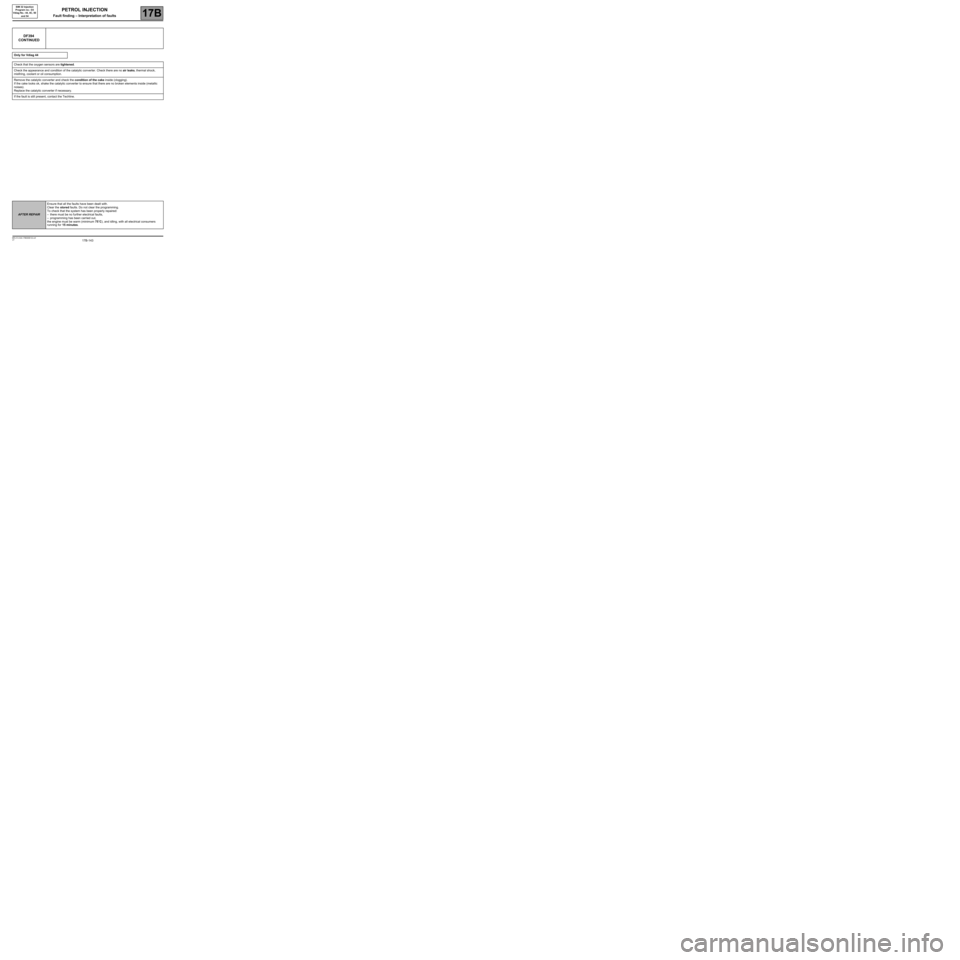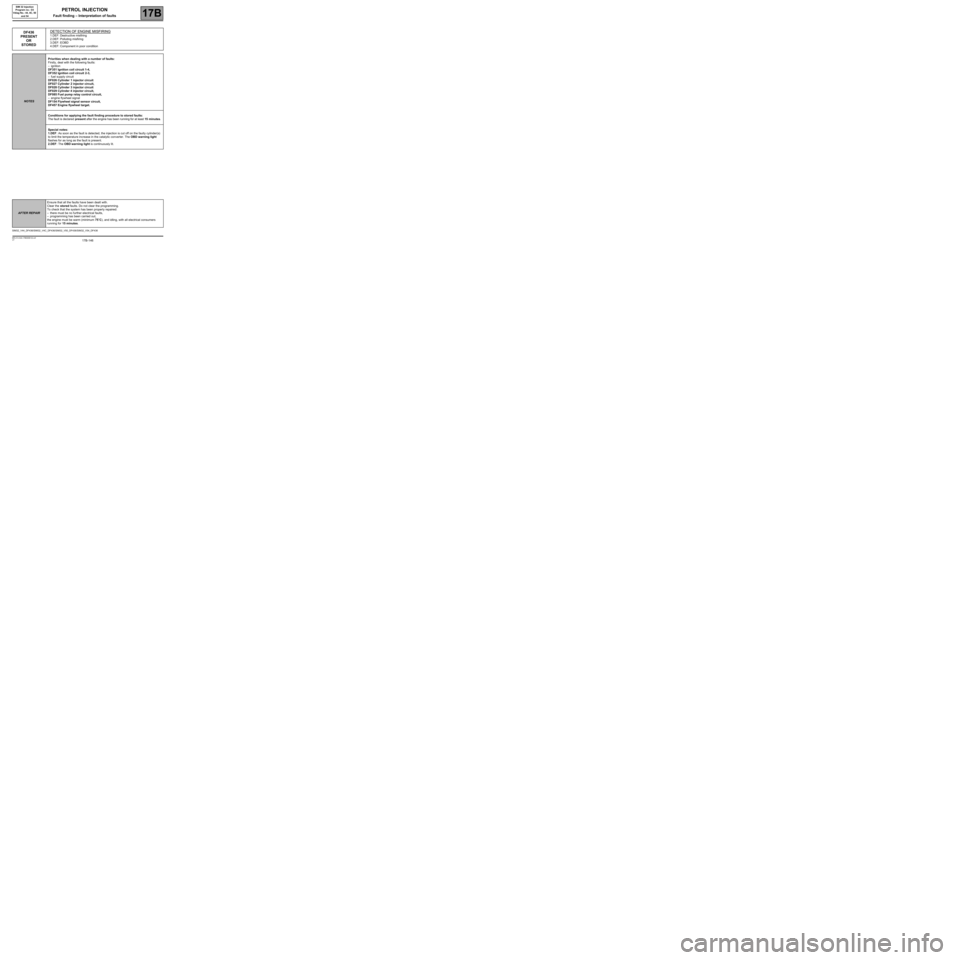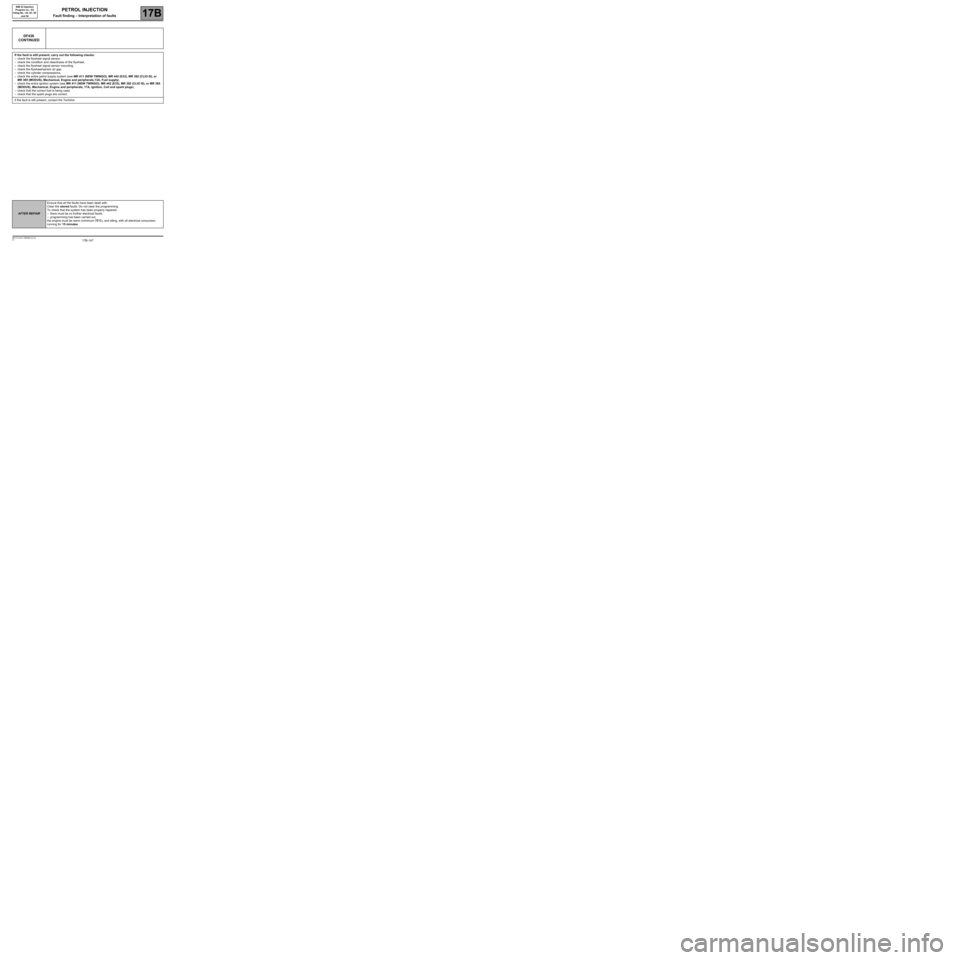2009 RENAULT TWINGO RS check oil
[x] Cancel search: check oilPage 142 of 348

17B-142V7 MR-413-X44-17B000$133.mif
PETROL INJECTION
Fault finding – Interpretation of faults17B
SIM 32 Injection
Program no.: D3
Vdiag No.: 44, 4C, 50
and 54
DF394
PRESENT
OR
STOREDCATALYTIC CONVERTER OPERATING FAULT
1.DEF: Component in bad condition
2.DEF: EOBD
NOTESPriorities when dealing with a number of faults:
Deal with any other fault first.
Conditions for applying the fault finding procedure to stored faults:
The fault is declared present after the engine starts.
Special notes:
The OBD warning light is lit.
Use the Wiring Diagrams Technical Note for NEW TWINGO, E33, CLIO III,
or MODUS.
Only for Vdiag 4C, 50 and 54
Check the appearance and condition of the catalytic converter. Check there are no air leaks, thermal shock,
misfiring, coolant or oil consumption.
Run command SC006 Running OBD Test: catalytic converter. Before carrying out this test, repair all the
electrical faults and clear the fault memory. Check that fault DF436 Misfiring detection is not present and program
the engine flywheel target ET089 Flywheel target programming.
Carry out this test when the engine is warm, which reduces the time it takes for the catalytic converter to heat up.
At the end of this test, four different results are possible:
–Status 1: Fault finding not carried out/impossible to obtain the necessary conditions.
–Status 2: Component in an average condition.
–Status 3: Component in good condition.
–Status 4: Component in poor condition.
When fault finding is completed and the result read, stop the engine and start it again to establish normal operating
conditions.
If the result is status 1: check that there are no faults, and check the engine flywheel target programming using
ET089 Programming engine flywheel target.
If the result is status 2 or 4: replace the catalytic converter.
If the result is status 3: the catalytic converter is in good condition.
If the fault is still present, contact the Techline.
SIM32_V44_DF394/SIM32_V4C_DF394/SIM32_V50_DF394/SIM32_V54_DF394
AFTER REPAIREnsure that all the faults have been dealt with.
Clear the stored faults. Do not clear the programming.
To check that the system has been properly repaired:
–there must be no further electrical faults,
–programming has been carried out,
the engine must be warm (minimum 75˚C), and idling, with all electrical consumers
running for 15 minutes.
Page 143 of 348

17B-143V7 MR-413-X44-17B000$133.mif
PETROL INJECTION
Fault finding – Interpretation of faults17B
SIM 32 Injection
Program no.: D3
Vdiag No.: 44, 4C, 50
and 54
DF394
CONTINUED
Only for Vdiag 44
Check that the oxygen sensors are tightened.
Check the appearance and condition of the catalytic converter. Check there are no air leaks, thermal shock,
misfiring, coolant or oil consumption.
Remove the catalytic converter and check the condition of the cake inside (clogging).
If the cake looks ok, shake the catalytic converter to ensure that there are no broken elements inside (metallic
noises).
Replace the catalytic converter if necessary.
If the fault is still present, contact the Techline.
AFTER REPAIREnsure that all the faults have been dealt with.
Clear the stored faults. Do not clear the programming.
To check that the system has been properly repaired:
–there must be no further electrical faults,
–programming has been carried out,
the engine must be warm (minimum 75˚C), and idling, with all electrical consumers
running for 15 minutes.
Page 146 of 348

17B-146V7 MR-413-X44-17B000$133.mif
PETROL INJECTION
Fault finding – Interpretation of faults17B
SIM 32 Injection
Program no.: D3
Vdiag No.: 44, 4C, 50
and 54
DF436
PRESENT
OR
STOREDDETECTION OF ENGINE MISFIRING1.DEF: Destructive misfiring
2.DEF: Polluting misfiring
3.DEF: EOBD
4.DEF: Component in poor condition
NOTESPriorities when dealing with a number of faults:
Firstly, deal with the following faults:
–ignition
DF351 Ignition coil circuit 1-4,
DF352 Ignition coil circuit 2-3,
–fuel supply circuit
DF026 Cylinder 1 injector circuit
DF027 Cylinder 2 injector circuit,
DF028 Cylinder 3 injector circuit
DF029 Cylinder 4 injector circuit,
DF085 Fuel pump relay control circuit,
–engine flywheel signal
DF154 Flywheel signal sensor circuit,
DF457 Engine flywheel target.
Conditions for applying the fault finding procedure to stored faults:
The fault is declared present after the engine has been running for at least 15 minutes.
Special notes:
1.DEF: As soon as the fault is detected, the injection is cut off on the faulty cylinder(s)
to limit the temperature increase in the catalytic converter. The OBD warning light
flashes for as long as the fault is present.
2.DEF: The OBD warning light is continuously lit.
SIM32_V44_DF436/SIM32_V4C_DF436/SIM32_V50_DF436/SIM32_V54_DF436
AFTER REPAIREnsure that all the faults have been dealt with.
Clear the stored faults. Do not clear the programming.
To check that the system has been properly repaired:
–there must be no further electrical faults,
–programming has been carried out,
the engine must be warm (minimum 75˚C), and idling, with all electrical consumers
running for 15 minutes.
Page 147 of 348

17B-147V7 MR-413-X44-17B000$133.mif
PETROL INJECTION
Fault finding – Interpretation of faults17B
SIM 32 Injection
Program no.: D3
Vdiag No.: 44, 4C, 50
and 54
DF436
CONTINUED
If the fault is still present, carry out the following checks:
–check the flywheel signal sensor,
–check the condition and cleanliness of the flywheel,
–check the flywheel signal sensor mounting,
–check the flywheel/sensor air gap
–check the cylinder compressions,
–check the entire petrol supply system (see MR 411 (NEW TWINGO), MR 442 (E33), MR 392 (CLIO III), or
MR 385 (MODUS), Mechanical, Engine and peripherals,13A, Fuel supply),
–check the entire ignition system (see MR 411 (NEW TWINGO), MR 442 (E33), MR 392 (CLIO III), or MR 385
(MODUS), Mechanical, Engine and peripherals, 17A, Ignition, Coil and spark plugs),
–check that the correct fuel is being used,
–check that the spark plugs are correct.
If the fault is still present, contact the Techline.
AFTER REPAIREnsure that all the faults have been dealt with.
Clear the stored faults. Do not clear the programming.
To check that the system has been properly repaired:
–there must be no further electrical faults,
–programming has been carried out,
the engine must be warm (minimum 75˚C), and idling, with all electrical consumers
running for 15 minutes.
Page 156 of 348

17B-156V7 MR-413-X44-17B000$133.mif
PETROL INJECTION
Fault finding – Interpretation of faults17B
SIM 32 Injection
Program no.: D3
Vdiag No.: 44, 4C, 50
and 54
DF612
PRESENT
OR
STOREDOIL VAPOUR DEFREEZE RESISTOR CIRCUIT
CO.0: Open circuit or short circuit to earth
CC.1: Short circuit to + 12 V
NOTESSpecial notes:
Oil leaks and odours are possible.
Use the Wiring Diagrams Technical Note for NEW TWINGO, E33, CLIO III,
or MODUS.
Check the condition of the connector of the oil vapour rebreathing hose heater (component code 979) and of the
engine management computer (component code 120).
If the connectors are faulty and if there is a repair procedure (see Technical Note 6015A, Repairing electrical
wiring, Wiring: Precautions for repair), repair the connector, otherwise replace the wiring.
With the ignition on, check for + 12 V on connection 3FB of the oil vapour re-breathing pipe heater and the earthing
of connection 3YC on the injection computer connector.
Use the universal bornier to check the insulation and continuity of the following connections:
●3FB between components 979 and 238,
●3YC between components 979 and 120 (for NEW TWINGO or E33),
●3JP between components 979 and 120 (for CLIO III or MODUS).
If the connection or connections are faulty and there is a repair procedure (see Technical Note 6015A, Electrical
wiring repair, Wiring: Precautions for repair), repair the wiring, otherwise replace it.
If the fault is still present, contact the Techline.
SIM32_V44_DF612 / SIM32_V4C_DF612 / SIM32_V50_DF612 / SIM32_V54_DF612
AFTER REPAIRFollow the instructions to confirm repair:
–If the fault is present, continue to deal with the fault.
–If the fault is stored, ignore it.
Deal with any other faults.
Clear the stored faults.
Page 196 of 348

17B-196V7 MR-413-X44-17B000$151.mif
PETROL INJECTION
Fault finding – Interpretation of statuses17B
SIM 32 Injection
Program no.: D3
Vdiag No.: 44, 4C, 50
and 54
ET054
CONTINUED
IDLING SPEED TOO LOW
Check:
–engine oil level (too high, splashing),
–that the exhaust pipe is not blocked (catalytic converter damaged),
–the cleanliness and conformity of the air filter,
–that the air inlet circuit is not blocked,
–that the throttle valve assembly is not clogged,
–the condition and conformity of the spark plugs,
–the fuel circuit sealing,
–the fuel pressure and the flow (see MR 392 (Clio III), MR 385 (Modus), MR 411 (New Twingo), or MR 442
(E33), Mechanical, 13A, Fuel supply),
–the condition and cleanliness of the injectors,
–the cylinder compression's,
–the timing setting.
Repair or replace the faulty components, if necessary.
IDLING SPEED TOO HIGH
Check:
–engine oil level (too high, splashing),
–for the fittings in the oil vapour rebreathing system,
–the sealing between the throttle valve and inlet manifold,
–the manifold pressure sensor sealing,
–the fuel vapour absorber bleed, which must not be jammed open,
–the fuel vapour absorber bleed system sealing,
–the brake servo system sealing,
–the sealing between the inlet manifold and cylinder head,
–the oil vapour recovery circuit sealing between the inlet manifold and cylinder head,
–the fuel pressure and the flow (see MR 392 (Clio III), MR 385 (Modus), MR 411 (New Twingo), or MR 442
(E33), Mechanical, 13A, Fuel supply),
–the condition and cleanliness of the injectors,
–the cylinder compression's,
–the timing adjustment,
Repair or replace the faulty components, if necessary.
AFTER REPAIRCarry out a road test, then check with the diagnostic tool.
Page 216 of 348

17B-216V7 MR-413-X44-17B000$152.mif
PETROL INJECTION
Fault finding – Interpretation of statuses17B
SIM 32 Injection
Program no.: D3
Vdiag No.: 44, 4C, 50
and 54
ET143
CONTINUED
Sensor electrical conformity
Check:
–the condition of the low-speed fan unit,
–that the low-speed fan resistance is correct,
–the cleanliness of the low-speed fan earth,
–the low-speed fan feed,
–the feed line between the low-speed fan and the low-speed fan relay.
Check the connection and condition of the connector of the low-speed fan assembly relay (component code 700)
and of the engine management computer (component code 120).
If the connector or connectors are faulty and if there is a repair procedure (see Technical Note 6015A, Electrical
wiring repair, Wiring: Precautions for repair), repair the connector, otherwise change the wiring.
Disconnect the low-speed fan relay. Check, with the ignition on, for 12 V on the connection 3FB of the relay.
If the connection is faulty and if there is a repair procedure (see Technical Note 6015A, Electrical wiring repair,
Wiring: Precautions for repair), repair the wiring, otherwise replace it.
Check the continuity of the relay coil.
Replace the low-speed fan relay if necessary.
Use the universal bornier to check the insulation and continuity of the following connection:
●3JN between components 120 and 700.
If the connection is faulty and if there is a repair procedure (see Technical Note 6015A, Electrical wiring repair,
Wiring: Precautions for repair), repair the wiring, otherwise replace it.
AFTER REPAIRCarry out a road test followed by a check with the diagnostic tool.
Page 218 of 348

17B-218V7 MR-413-X44-17B000$152.mif
PETROL INJECTION
Fault finding – Interpretation of statuses17B
SIM 32 Injection
Program no.: D3
Vdiag No.: 44, 4C, 50
and 54
ET144
CONTINUED
Check:
–the condition of the high-speed fan unit,
–that the high-speed fan resistance is correct,
–the cleanliness of the high-speed fan earth,
–the high-speed fan feed,
–the feed line between the high-speed fan and the high-speed fan relay.
Check the connection and condition of the high-speed fan assembly relay connector (component code 234) and
the engine management computer connector (component code 120).
If the connector or connectors are faulty and if there is a repair procedure (see Technical Note 6015A, Electrical
wiring repair, Wiring: Precautions for repair), repair the connector, otherwise change the wiring.
Disconnect the high-speed fan relay. Check, with the ignition on, for 12 V on the connection 3FB of the relay.
If the connection is faulty and if there is a repair procedure (see Technical Note 6015A, Electrical wiring repair,
Wiring: Precautions for repair), repair the wiring, otherwise replace it.
Check the continuity of the relay coil.
Replace the high-speed fan relay if necessary.
Use the universal bornier to check the insulation and continuity of the following connection:
3JP between components 120 and 234.
If the connection is faulty and if there is a repair procedure (see Technical Note 6015A, Electrical wiring repair,
Wiring: Precautions for repair), repair the wiring, otherwise replace it.
Repair if necessary.
AFTER REPAIRCarry out a road test followed by a check with the diagnostic tool.